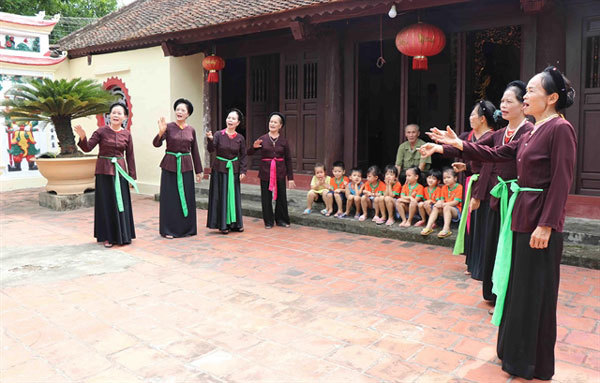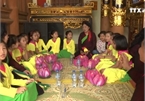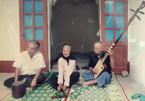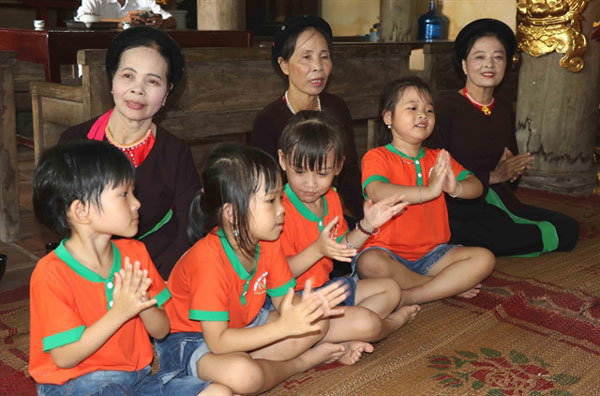|
Bui Xa upholds singing tradition
|
| GET INVOLVED: Children are encouraged to join Bùi Xá Hát Trống Quân Club. VNA/VNS Photos Diep Truong |
According to Le Thi Mao, 94, the art reached its golden time before the August Revolution in 1945.
"At that time, this kind of folk singing was the only kind of entertainment among locals," she recalls.
“In the village, all people, old and young, knew how to sing,” she says. “Many young couples got married after singing rehearsals. They courted one another through the songs.”
Mao says she loved the art at a young age and accompanied her brothers and sisters to performances.
At 18, she performed at night shows. She also got married to a drum player after performing at such shows.
After 1945, the art got less popular, until it was revived in 1993.
In 2003, the first club of folk singing and playing drums was established, which now features dozens of members.
People sing live without any musical instruments, apart from the drums of course.
“At performances, artists sing in order songs of greetings, welcoming, wishing and asking,” says Le Ba Dao, 77, a member of the club.
“Different from singing with drums in other areas in the north, local lyrics are simple, with quick rhythms, while the sounds echo well for a long time,” he says.
The techniques require a strong voice, passion and the capability to respond quickly at contests, he adds.
Artists in the village play a special instrument – a drum made of clay.
 |
| HARMONY: Club members often gather at Bui Xa Communal House to rehearse. |
The instrument consists of a bar of wood placed vertically, with two bamboo sticks on the two sides of the bar. Women would stand on a stick side, while men on the opposite. The two sticks are connected by a metal string. In the middle of the string, a drum is placed on the wooden bar. The string is placed on the face of the drum. When the player beats the string end near a stick, the string vibrates on the drum and creates sound.
In the past, people used the clay drum exclusively, but now a normal wooden drum can be used instead.
The club meets each weekend night with about 30 members in attendance, where they practise old songs and write down lyrics and record songs on CDs based on ancient melodies composed by the artists.
As many as 130 songs have been recorded.
The Ministry of Culture, Sports and Tourism added the art to its list of national intangible cultural heritages, and three veteran artists have been honoured for their contributions to teaching the art to youths.
Thu says her biggest fear is that teaching activities are now mostly aimed at those above the age of 50 in the club.
“Our first and foremost desire is to be supported by local cultural authorities to open more training classes for younger people,” she says.
“Besides training at the club, we also should set up a teaching programme at schools for children,” she suggests. VNS
Thanh Thuong

Bac Ninh focuses on preserving Quan ho folk singing
“Quan ho” or love duet singinghas been well preserved and developed in its cradle, Bac Ninh province. This is attributed to the province’s efforts in conserving their traditional art genre.

People’s Artist preserves folk singing of Quang Ninh province
“Nha to” folk singing, also called “Cua dinh” folk singing, in Quang Ninh province has been recognized as a national intangible cultural heritage.
 The art of folk singing alongside drums, hát trống quân in Vietnamese, started in Bui Xa Village, in today’s Thuan Thanh District, the northern province of Bac Ninh, in the 13th century, but locals still practise the art.
The art of folk singing alongside drums, hát trống quân in Vietnamese, started in Bui Xa Village, in today’s Thuan Thanh District, the northern province of Bac Ninh, in the 13th century, but locals still practise the art.